Explore Nara - Japan Travel, Asia
Nestled in the heart of Japan, Nara is a city that effortlessly bridges the ancient and the modern. As one of Japan's most well-preserved historical sites, it offers a window into the country’s rich past while providing a serene and engaging experience for today’s travelers. From its sacred temples and vibrant cultural festivals to its friendly locals and exquisite cuisine, Nara promises a unique journey through time and tradition.
Looking for an unforgettable journey through Japan? Explore our premium tours here and start planning your adventure
Population: Approximately 367,000 in 2022.
Economy: Capital city of Japan during the Edo era and the example for the success in both eco-tourism.
Landmarks: Todai-ji Temple, Kofuku-ji Temple, and Himuro Shrine
Japan
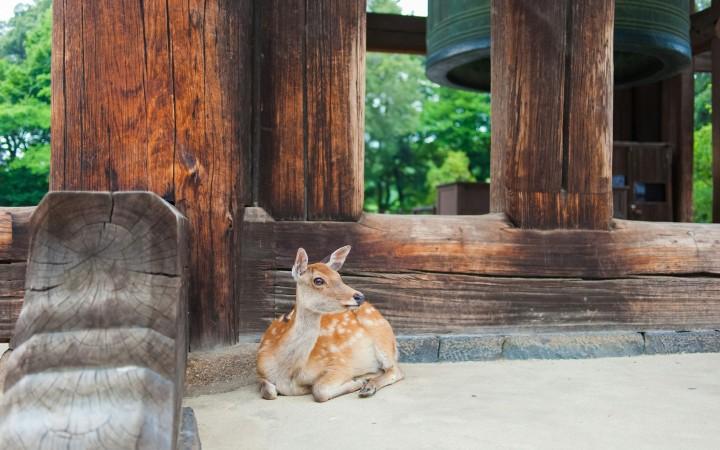
Overview of Nara
History & Cultural Influence
Nara's significance in Japanese history is unparalleled. Established as Japan’s first permanent capital in 710 AD, the city played a pivotal role in shaping Japanese culture and governance. Today, Nara's historical heritage is woven into its stunning array of ancient temples, shrines, and traditional architecture. The city is home to several UNESCO World Heritage Sites, including Todai-ji Temple and Kasuga Taisha Shrine. These landmarks are not just architectural marvels; they embody the spiritual essence of Nara and reflect the profound influence of Buddhism on Japanese culture.
Interaction with The Locals
Nara has a population of approximately 367,000 residents. This relatively small city, located in the Kansai region of Japan, is known for its rich historical heritage and tranquil environment. The city’s population reflects its role as a center for history and tourism, maintaining a balance between preserving its past and accommodating modern needs.
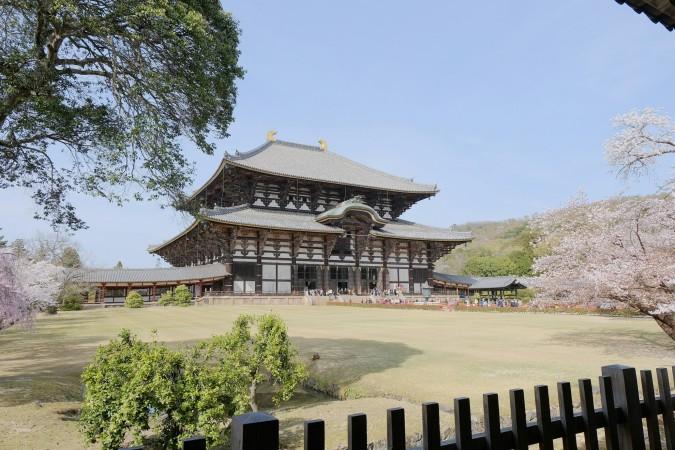
Todai-ji Temple - © Rustam Kakar
Top Attractions in Nara
Nara is a treasure trove of historical and cultural landmarks, each offering a distinct perspective on Japan's rich history. Each of these attractions provides a different facet of Nara’s cultural and historical landscape, ensuring that your visit will be both enriching and memorable. Here are the must-visit attractions in Nara you shouldn't miss:
- Todai-ji Temple: Home to the Great Buddha (Daibutsu), this monumental bronze statue is a symbol of Nara’s historical significance. The temple's Daibutsuden, or Great Buddha Hall, is the largest wooden building in the world and offers an awe-inspiring experience.
- Nara Park: Famous for its friendly, free-roaming deer, Nara Park is a must-visit. The park covers 660 hectares and provides a picturesque setting for leisurely walks, picnicking, and deer feeding. The park is also home to several significant temples and shrines
- Kofuku-ji Temple: This UNESCO World Heritage Site features a stunning five-story pagoda and a wealth of Buddhist artifacts housed in its National Treasure Museum. The temple grounds are perfect for exploring ancient Japanese art and architecture.
- Naramachi: Wander through this well-preserved historic district to experience traditional Edo-period Japan. The area features narrow streets lined with charming wooden houses, historic shops, and cozy cafes.
- Toshodai-ji Temple: Founded in 759 AD, this temple is one of Nara’s significant historical sites. Known for its elegant architecture and historical importance, Toshodai-ji offers a tranquil atmosphere and an opportunity to explore Japan's early Buddhist culture.
- Himuro Shrine: This lesser-known Shinto shrine is dedicated to the god of ice and features a unique blend of historical and natural beauty. The shrine is well-known for its gorgeous surroundings and the local folklore linked with it.
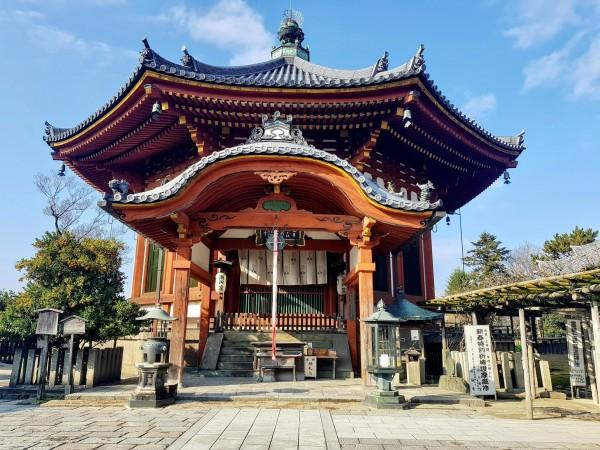
Kofuku-ji Temple - © Andrei Daniel Petrica
Must-Try Dishes in Nara
Nara’s cuisine is a feast for the senses, offering a diverse array of local specialties that reflect the city’s rich cultural heritage. These dishes not only highlight the unique flavors of Nara but also provide a delicious insight into the region’s culinary traditions. When exploring Nara, be sure to savor these delicious and traditional dishes:
- Kakinoha-zushi: A distinctive style of sushi where fish, typically mackerel or salmon, is wrapped in persimmon leaves. The leaves impart a subtle, fragrant aroma to the sushi, making it a unique and flavorful experience.
- Miwa Somen: These thin, white noodles are a local specialty from the Miwa area. Known for their delicate texture, Miwa somen are usually served cold with a light dipping sauce, perfect for a refreshing meal, especially in the warmer months.
- Nara Pickles (Narazuke): Nara is famous for its pickles, which are made from seasonal vegetables and fermented in sake lees. Narazuke pickles are famous for their rich, nuanced tastes and are frequently served as a side dish or complement to rice.
- Yakitori: Skewered and grilled chicken pieces, seasoned with salt or a savory sauce. Nara’s yakitori stands out for its juicy, flavorful meat, making it a popular choice among locals and visitors alike.
- Tsukemono: Traditional Japanese pickles that offer a crunchy and tangy complement to meals. In Nara, you'll find a variety of tsukemono, including those made from local vegetables and prepared using time-honored methods.
- Sakuramochi: A sweet treat made from glutinous rice flour and filled with sweet red bean paste, wrapped in a pickled cherry leaf. This seasonal delicacy is particularly popular during cherry blossom season.
- Hōba Miso: A traditional dish from the surrounding area of Nara, Hōba Miso features miso paste grilled on a magnolia leaf. The paste is typically mixed with vegetables and meats, offering a rich, smoky flavor.
Curious about Takayama? Learn more about what makes this spot so special in our detailed article.
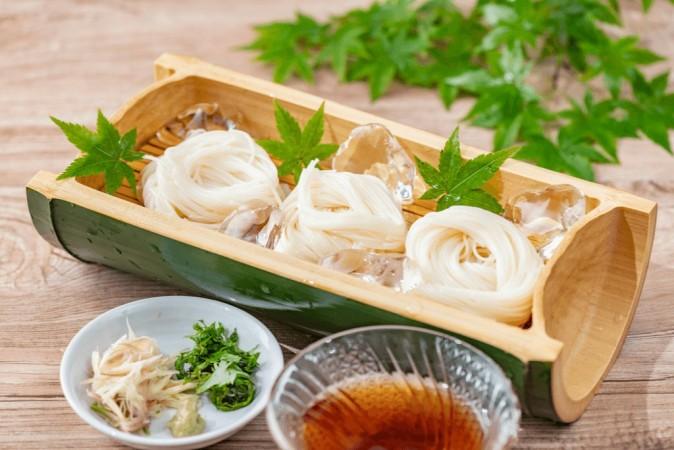
Miwa Somen - © Sakuraco
Festivals & Local Celebrations
Nara’s vibrant festivals and local celebrations offer an immersive experience into the city’s cultural traditions. These festivals not only showcase traditional Japanese customs but also provide a festive atmosphere for visitors to experience local culture.
- Nara Tōka-e: This event takes place in August and comprises hundreds of lanterns that illuminate Nara Park and the surrounding surroundings. The event creates a magical atmosphere, blending light with historical landmarks.
- Omizutori: Known as the “Water Drawing Festival,” this event takes place in March at Todai-ji Temple. It involves a dramatic ceremony where monks draw water from a sacred well, symbolizing the start of spring and the purification of the community.
- On-Matsuri Festival: Celebrated in January at Kasuga Taisha Shrine, this festival involves processions of people carrying large torches, which create a striking visual effect and are believed to drive away evil spirits.
- Nara Kōen Gion Matsuri: Held in July, this festival features traditional dance performances, music, and parades, offering a lively and colorful celebration of Nara’s cultural heritage.
What to Do in Nara
Nara offers a variety of engaging activities that cater to diverse interests, providing a well-rounded experience of this destination, whether it is blending cultural immersion or outdoor adventures.
- Hiking and Nature Walks: Explore the scenic trails around Nara Park and Mount Wakakusa. Hiking provides stunning views and a chance to experience Nara’s natural beauty up close.
- Cultural Workshops: Participate in traditional Japanese activities such as tea ceremonies, calligraphy, or ikebana (flower arranging). These workshops offer a hands-on way to engage with Japanese culture.
- Deer Feeding in Nara: Visitors to Nara Park may feed and engage with the famed free-roaming deer. The experience is both enjoyable and educational, offering insights into the local wildlife.
- Visit Museums: Discover Nara’s rich history at the Nara National Museum, which features a collection of Buddhist art and artifacts. The museum’s exhibitions provide a deeper understanding of the region’s cultural heritage.
- Traditional Craft Experiences: Try your hand at local crafts, such as pottery or weaving, in workshops that offer a glimpse into traditional Japanese craftsmanship.

Feeding deer in Nara Park - © Spenser Sembrat
Weather in Nara: Best Time to Visit
Nara’s weather plays a significant role in shaping the tourism experience throughout the year. By understanding Nara’s weather trends, travelers can plan their visit to align with their preferred seasonal experiences and make the most of their trip.
Spring in Nara
- Weather: With daytime temperatures ranging from 10°C to 20°C (50°F to 68°F), it's perfect for exploring outdoor attractions like Nara Park and participating in seasonal festivals.
- Tourism Trend: The cherry blossom season, particularly in early April, draws both domestic and international visitors eager to witness the picturesque landscapes and celebrate Hanami (flower viewing).
Summer in Nara
- Weather: Summer is characterized by excessive humidity and temperatures that frequently reach 30°C (86°F).
- Tourism Trend: Despite the heat, this season is vibrant with festivals and events, such as the Nara Tōka-e, where thousands of lanterns illuminate the city. The summer months also offer unique experiences like traditional Japanese matsuri (festivals), which highlight local culture and traditions.
Autumn in Nara
- Weather: Daytime temperatures range from 15°C to 25°C (59°F to 77°F), making it comfortable for sightseeing and outdoor activities.
- Tourism Trend: Autumn is another peak season for tourism in Nara, celebrated for its stunning fall foliage. The colorful autumn leaves attract visitors to Nara Park and the ancient temples, providing a beautiful backdrop for photography and nature walks.
Winter in Nara
- Weather: Winter in Nara is relatively mild compared to other Japanese cities, with temperatures ranging from 0°C to 10°C (32°F to 50°F). While snowfall is rare, the crisp winter air and fewer crowds offer a tranquil experience.
- Tourism Trend: This season is perfect for those seeking a quieter time to explore historical sites and enjoy the peaceful atmosphere. Winter is also a great time to experience New Year’s traditions and winter festivals, which provide a unique cultural insight.
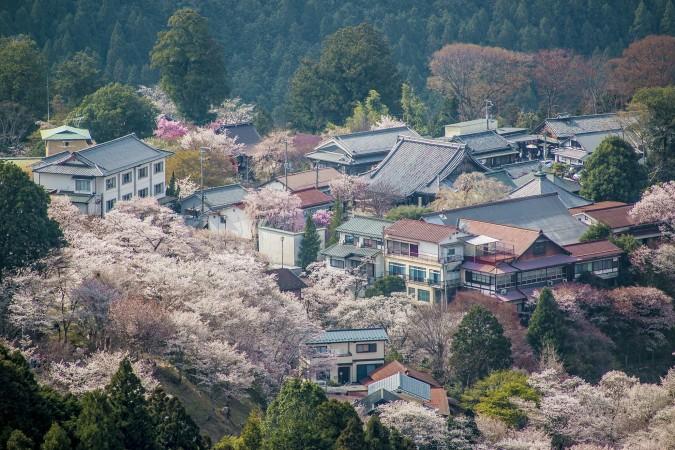
Cherry Blossom season in Nara - © QUENTIN Mahe
Shopping in Nara
Shopping in Nara provides a blend of historical charm and modern convenience, ensuring that visitors can find something special to remember their trip by. You can either choose a hand-craft traditional souvenirs or some cute collectibles with modern touch:
- Higashimuki Shopping Street: This bustling pedestrian street features a variety of shops, from traditional crafts to modern boutiques. It’s an ideal place for visitors to choose from a wide range of souvenirs and gifts.
- Naramachi: Explore this historic district for unique local products, including traditional textiles, pottery, and antiques. The area’s quaint shops and historic ambiance add to the shopping experience.
- Nara Machi Museum Shop: Located in the Naramachi district, this shop offers a range of locally made crafts and artisanal products. It’s a great place to find distinctive souvenirs.
- Kintetsu Department Store: For a more contemporary shopping experience, visit this department store, which offers a wide range of fashion, electronics, and lifestyle products.
- Local Food Markets: Don’t miss the chance to explore Nara’s food markets, where you can find fresh local produce, specialty foods, and traditional snacks.
Want to know about Fukui-Shi? Check out our insights here and see why it's worth a visit.
Culture Etiquette in Nara
Experiencing Nara’s rich culture also means respecting local customs and etiquette. Following these etiquette guidelines will enhance your experience and show respect for Nara’s cultural heritage.
- Respect Sacred Sites: When visiting temples and shrines, dress modestly and behave respectfully. Remove your shoes before entering indoor areas, and follow any specific rules posted at the site.
- Proper Use of Chopsticks: Avoid sticking chopsticks upright into a bowl of rice, as this resembles a funeral practice. Instead, place them neatly on a chopstick rest or across the bowl.
- Quiet Behavior: Maintain a quiet demeanor in religious and cultural sites to preserve the peaceful atmosphere. Loud conversations and disruptive behavior are generally discouraged.
- Politeness and Bowing: Bowing is a common form of greeting and showing respect in Japan. A small nod or bow when interacting with locals is appreciated and reflects good manners.
- Handling Trash: Public trash bins are rare, so it’s customary to carry your waste with you until you find a suitable disposal point. This practice helps maintain cleanliness in public spaces.
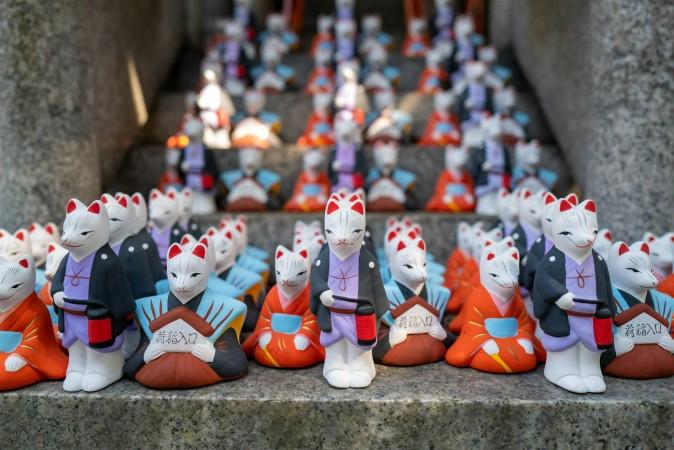
Japanese fox collectibles - © Gilly
Essential Travel Information
Getting Around Nara
Exploring Nara is stress-free owing to its effective transportation system. The city is well-served by trains, with major stations like Nara Station and Kintetsu Nara Station offering convenient connections to Kyoto and Osaka. Local buses are frequent and cover key tourist spots, including Nara Park and Todai-ji Temple, providing easy access to major attractions. Renting a bicycle is a popular choice for exploring at your own pace, with numerous rental shops available near train stations and major sites. Taxis are also readily available for those with heavy luggage or in groups and can be hailed or booked via phone or app. Furthermore, many of Nara's attractions are within walking distance of one another, making strolling an enjoyable way to take in the city's charm and historical monuments.
ATM & Banking Services
Nara provides comprehensive banking and ATM services to cater to visitors' needs. ATMs are easily accessible across the city, including at major train stations and various banks. Currency exchange is also available at some hotels and tourist information centers. While credit and debit cards are generally accepted at restaurants, stores, and hotels, it's best to bring extra cash for smaller businesses and local markets. Overall, Nara's banking facilities make managing finances during your visit straightforward and convenient.
Where to Stay in Nara
Nara offers a diverse array of accommodation options to suit various preferences and budgets. For a luxurious stay, high-end hotels provide premium amenities and exceptional service, often with scenic views of the city or nearby landmarks. Travelers seeking a traditional Japanese experience can enjoy staying in a ryokan, where they’ll find tatami mats, futons, and authentic Japanese meals. Budget-conscious travelers can opt for guesthouses and hostels, which provide a friendly atmosphere and a chance to meet fellow travelers.
Articles for you

Experience Aboard The RV Indochine II - A Mekong Cruise With Tweet World Travel
The RV Indochine II is a luxury river cruise ship, offering an unforgettable journey through many attractions along the Mekong River. Built in 2017, this upscale vessel combines colonial elegance with modern conveniences to create a comfortable yet stylish environment for its crew and passengers. The ship’s intimate size makes it ideal for those seeking a more personal cruising experience while exploring Vietnam and Cambodia rich culture, scenery, and heritage. Whether you're gazing at the landscape from your private balcony or enjoying authentic local cuisine, RV Indochine II promises an exotic adventure like no other.

Witness Stilt Fishing In Sri Lanka: An Eco-Tourism Experience
Sri Lanka, renowned for its stunning beaches and rich cultural heritage, harbors a unique tradition that has captivated travelers for centuries: stilt fishing. This ancient practice, passed down through generations of coastal communities, blends artistry with necessity, offering a glimpse into a way of life intimately connected to the island's coastal rhythms. Stilt fishing in Sri Lanka isn't merely a means to catch fish; it's a cultural emblem, embodying the resilience and ingenuity of Sri Lanka's fishing communities.

Make Your Trip Stress-Free With The Tweet Trip App
Embark on your next adventure with confidence by downloading the Tweet Trip App, available for both iOS and Android. This essential travel companion allows you to view your detailed itinerary, stay connected with your tour guide and fellow travelers, receive real-time updates, and provide feedback effortlessly. With features like in-app messaging, emergency assistance, and location sharing, the Tweet Trip App ensures you travel smarter, stay connected, and enjoy a seamless, worry-free journey. Get started today and make the most of your travel experience with Tweet World Travel.

Pedal Through Paradise: Unveiling Cambodia's Hidden Gems on Two Wheels
The gentle whir of bicycle wheels mingles with the distant chants of monks as you glide past emerald rice paddies stretching to the horizon. This is Cambodia - a sensory explosion waiting to be experienced on two wheels. At Tweet Tours, we believe there's no better way to immerse yourself in the Kingdom of Wonder than by bicycle.
Cambodia isn't just a destination; it's a living, breathing tapestry of ancient wonders, natural beauty, and vibrant culture. Our carefully crafted cycling tours take you beyond the typical tourist haunts, offering a unique perspective on this captivating country. Ready to clip in and discover the magic of Cambodia? Let's ride!

Trekking in the Himalayas: A Journey Through Nepal's Majestic Peaks
The Himalayas rise from the earth like colossal guardians, their snow-capped peaks piercing the sky in a display of nature's raw power and beauty. Nepal, nestled at the heart of this mountain range, serves as the gateway to some of the most breathtaking trekking experiences on the planet. Here, the air is crisp and thin, filled with the promise of adventure and the whispers of ancient tales.
With Tweet Tours, as you set foot on these hallowed trails, you're not just a traveler - you're a modern-day explorer, following in the footsteps of legendary mountaineers and age-old traders. Each step takes you further into a world where nature reigns supreme and human resilience is tested against the backdrop of some of the world's highest peaks.
From the moment your boots touch the ground in Kathmandu, you'll feel the pull of the mountains. The bustling streets of the capital, with their sensory overload of sights, sounds, and smells, soon give way to serene mountain paths where the only soundtrack is the crunch of gravel underfoot and the distant tinkling of yak bells.

Exploring Mui Ne's Wonders: Unique Attractions & Local Dishes
Nestled along the southeastern coast of Vietnam, Mui Ne emerges as a captivating gem, blending natural wonders with cultural richness. Renowned for its stunning landscapes and unique attractions, Mui Ne beckons travelers seeking both relaxation and adventure in equal measure. Mui Ne's renowned beach dunes, bustling fishing towns, and excellent local food await exploration at every turn.
The allure of Mui Ne lies not only in its pristine beaches and crystal-clear waters but also in its diverse range of activities catering to every traveler's whims. Whether you're drawn to thrilling water sports like kitesurfing and windsurfing on its dynamic shores or seeking tranquility amidst the picturesque Fairy Stream, Mui Ne promises an unforgettable journey filled with discovery.
